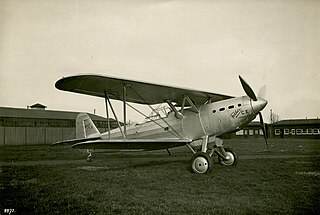
The Fokker C.X was a Dutch biplane scout and light bomber designed in 1933. It had a crew of two.

The de Havilland DH.84 Dragon is a successful small commercial aircraft that was designed and built by the de Havilland company.

The Fokker F.VII, also known as the Fokker Trimotor, was an airliner produced in the 1920s by the Dutch aircraft manufacturer Fokker, Fokker's American subsidiary Atlantic Aircraft Corporation, and several other companies under license. It was an airliner that could carry 6-12 people, depending on the version, and it used a variety of engines; early versions had one engine but three was more common.

AB Aerotransport (ABA) was a Swedish government-owned airline which operated during the first half of the 20th century and was merged into what would become the SAS Group. ABA was established on 27 March 1924 under the name Aktiebolaget Aerotransport by Carl and Adrian Florman together with Ernst Linder, John Björk och Johan Nilsson. Its first flight was on 2 June 1924 between Stockholm, Sweden and Helsinki, Finland. Needing more funds, it became government-owned in 1935. ABA was merged with Swedish Intercontinental Airlines (SILA) in 1948 and airline operations would ultimately be merged into the international SAS Group in 1950.

The Fokker F.VIII was a large twin-engined airliner designed and produced by the Dutch aircraft manufacturer Fokker in the 1920s.

The de Havilland DH.61 Giant Moth was a 1920s British large single-engined biplane transport built by de Havilland at Stag Lane Aerodrome, Edgware. Intended primarily for use in Australia, a number were also shipped to Canada.

The Airspeed AS.4 Ferry was three-engined ten-seat biplane airliner designed and built by the British aircraft manufacturer Airspeed Limited. It was the company's first powered aircraft to be produced.

The Airspeed AS.30 Queen Wasp was a British pilotless target aircraft built by Airspeed Limited at Portsmouth during the Second World War. Although intended for both Royal Air Force and Royal Navy use, the aircraft never went into series production.

The Fokker F.IX was an airliner developed in the Netherlands in the late 1920s, intended to provide KLM with an aircraft suitable for regular services to the Dutch East Indies. When the onset of the Great Depression forced the postponement of those plans, the market for this aircraft disappeared as well, although it did see military service in Czechoslovakia as a bomber.

The Fokker F.XX was a 1930s Dutch three-engined airliner designed and built by Fokker. It was the first Fokker design to use an elliptical-section fuselage instead of the traditional square fuselage and the first Fokker aircraft with retractable landing gear.

The Fokker F.XXXVI was a 1930s Dutch four-engined 32-passenger airliner designed and built by Fokker. It was the largest transport designed and built by Fokker. Only one was built, and it was used for some commercial routes starting in 1935, and later aviation training by the British Royal Air Force until 1940.

The Fokker F.III was a single-engined high-winged monoplane aircraft produced in the 1920s by the Dutch aircraft manufacturer Fokker. It could carry five passengers. The aircraft was also built under licence in Germany as the Fokker-Grulich F.III.

The Fokker F.XII was a three-engined high-winged monoplane airliner produced in the 1930s by the Dutch aircraft manufacturer Fokker. Two aircraft were built under license by Danish Orlogsværftet. The first was powered by 347 kW (465 hp) Bristol Jupiter VI radial engines and the second, an improved model, the F.XIIM, was about 20 km/h (12 mph) faster than the Dutch-built F.XIIs.

The Fokker F.XIV was a cargo plane built in the Netherlands in the late 1920s by Fokker. It was a high-wing cantilever monoplane of conventional trimotor layout. The sole example was tested by KLM but never put into service.

The Northrop Delta was an American single-engined passenger transport aircraft of the 1930s. Closely related to Northrop's Gamma mail plane, 13 were produced by the Northrop Corporation, followed by 19 aircraft built under license by Canadian Vickers Limited.

Scottish Airlines (Prestwick) Limited was formed in 1946 as a subsidiary of Scottish Aviation Limited. The airline commenced worldwide passenger and cargo charter flights from bases at Prestwick and Stansted. It also participated in the Berlin Airlift, became a trooping carrier for the British Armed Forces, and began contract flights on behalf of Air France, British European Airways (BEA), Compagnie Belge des Transports Aériens, Iceland Airways and KLM.

The Douglas DC-2 is a 14-passenger, twin-engined airliner that was produced by the American company Douglas Aircraft Company starting in 1934. It competed with the Boeing 247. In 1935, Douglas produced a larger version called the DC-3, which became one of the most successful aircraft in history.

On 14 July 1935 Fokker F.XXII PH-AJQ Kwikstaart was an international passenger flight from Amsterdam via Hamburg and Copenhagen to Malmö. The plane crashed and burned down shortly after take-off just outside Schiphol after both left side engines failed due to a defect in the fuel system, killing four crew members and two passengers. Fourteen people survived.




















